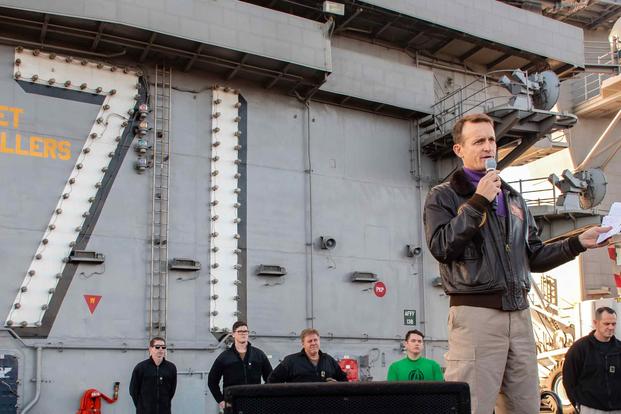The commanding officer of an aircraft carrier sidelined in Guam says there are more than 100 positive cases of the illness caused by the coronavirus among its crew and is calling on Navy leadership to do more to protect the lives of his sailors.
Navy Capt. Brett Crozier, commanding officer of the aircraft carrier Theodore Roosevelt, wrote a four-page letter to his superiors, pleading with them to take action to help stem the spread of COVID-19 cases on his ship. The San Francisco Chronicle obtained a copy of Crozier's letter and broke the story of his stunningly candid request that Navy leaders fix what he says is an ineffective strategy that will only slow the spread on the carrier -- not stop it.
"We are not at war. Sailors do not need to die," the captain wrote. "If we do not act now, we are failing to properly take care of our most trusted asset -- our Sailors."
Between 150 and 200 crew members on the carrier have tested positive for COVID-19, the Chronicle reported. The ship is pierside in Guam, but much of the crew remains on the ship.
Related: 'We Are Putting Lives in Danger': Recruiters Urge Boot Camp Closures Amid Pandemic
The number of COVID-19 cases has spiked in just seven days since the Navy announced the first three positive cases aboard the warship.
Crozier described the spread of the disease as ongoing and accelerating. It's impossible to practice social distancing measures on the ship, he added.
The Navy must offload the entire crew so the sailors can be properly quarantined, which the captain acknowledges is an extraordinary measure. But the ship must be cleaned, he said.
"Keeping over 4,000 young men and women on board the TR is an unnecessary risk and breaks faith with those Sailors entrusted to our care," Crozier wrote.
He cited close living quarters, food being prepared by people who've been exposed to the virus, and shared restrooms as reasons the ship needs to be emptied now.
Navy officials said in a statement responding to the letter that leaders are moving quickly to take all necessary steps to ensure the health and safety of the crew.
"The ship's commanding officer advocated for housing more members of the crew in facilities that allow for better isolation," the statement reads. "Navy leadership ... is pursuing options to address the concerns raised by the commanding officer."
Recruiters last week raised similar alarms about the military's decision to continue shipping new recruits to boot camp during a global pandemic. Recruits in entry-level training also live in tight quarters, they warned, saying it was only a matter of time before the COVID-19 illness spread wildly at one of the services' training camps.
The Roosevelt isn't the only Navy ship with coronavirus cases onboard. Fox News reported last week that there were two positive cases on the carrier Ronald Reagan, which is in port in Japan, where it's based.
There are also cases among crews assigned to the amphibious assault ship Boxer, guided-missile destroyer Ralph Johnson and littoral combat ship Coronado.
Defense Secretary Mark Esper directed the military to stop publicizing how many COVID-19 cases there are on each ship or in specific units or squadrons, citing operational security.
The Navy's top leaders said last week that all members of the carrier Roosevelt's crew would be tested for COVID-19. The first cases emerged after the ship made a port call in Vietnam in early March, despite warnings that the virus was likely to sweep through the Asia-Pacific region.
Sailors left the ship for receptions, sports competitions and other events.
When asked why leaders approved that move, Chief of Naval Operations Adm. Michael Gilday said there were only 16 reported cases in Vietnam at the time.
"Those were well to the north and all isolated in Hanoi," Gilday told reporters recently. "This was a very risk-informed decision, actually by the [head of U.S. Indo-Pacific Command Adm. Phil] Davidson, on whether or not we proceeded with that port visit."
Navy officials did not immediately respond to questions about whether all of the crew members have been tested for COVID-19, as planned.
While testing is important, Crozier wrote that it can't be a substitute for moving all crew members off the carrier. He noted that about a fifth of the first 33 sailors to test positive originally tested negative. They showed symptoms days after their initial tests, he said.
"Testing has no direct influence on the spread of the COVID-19 virus," Crozier wrote. "It merely confirms the presence of the virus."
-- Gina Harkins can be reached at gina.harkins@military.com. Follow her on Twitter @ginaaharkins.
Related: Tell Us: Is Your Command Doing Enough to Stop the Spread of Coronavirus?













